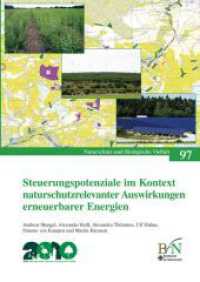- ホーム
- > 洋書
- > 英文書
- > History / World
Full Description
Building between the Two Rivers aims to supply university students and scholars of Near Eastern archaeology with an introduction to 'Building archaeology' methods as applied to the context of Ancient Mesopotamia. It helps the reader understand the principles underlying the discipline, which deals with the registration and analysis of all building materials and techniques involved in the assembly and erection of a construction, and to outline what knowledge and skills are needed, beyond those that are specific to archaeologists.
The in-depth registration and analysis of building materials and techniques requires professional skills and experience, which cannot be achieved with only a standard university training in archaeology. However, archaeologists need to know the basics of the classification of building materials, their physical properties, the main techniques of their finishing, as well as the basic principles of statics. They should also be able to let architects understand how to better tune the registration of data to ensure a fruitful archaeological interpretation.
Due to the introductory nature of the book, contents are organised in didactic chapters, trying to cover all the main topics and displaying them by means of selected examples. Particular attention is given to the methods of the 'stratigraphic reading', which are discussed in a dedicated appendix authored by Piero Gilento. A thematic bibliography and a technical glossary complete the book, helping readers enhance their understanding of the subject.
Contents
Preface ;
Building archaeology: goals and methods ;
Building archaeology ;
The building survey and stratigraphy ;
Direct and indirect sources ;
The Mesopotamian context ;
Land use and water management ;
Urbanisation and city planning ;
Ancient cartography, topography and surveying ;
Commissioners, designers and builders ;
Ancient building crafts and technology ;
Building materials ;
Building materials: general characteristics ;
Earth architecture ;
Stone ;
Mortar ;
Bitumen ;
Wood and reeds ;
Metals ;
Claddings and decorations ;
Architectural elements ;
Load-bearing structural systems: general features ;
Walls ;
Arches, vaults and domes ;
Pillars and columns ;
Openings ;
Staircases ;
Domestic and urban structures for water management ;
Pavements, ceilings and roofs ;
Building types ;
Ziggurats and temples ;
Palaces ;
Fortifications ;
Houses, storage- and workplaces ;
Roads, streets, bridges ;
Infrastructures for the water management ;
Gardens and orchards ;
Portable shelters ;
Funerary buildings ;
Conclusions ;
Appendix: the methods of building archaeology - (Piero Gilento) ;
What is and what does 'building archaeology' deal with? ;
Architectural stratigraphy ;
What is a Stratigraphic Building Unit (SBU)? ;
What stratigraphic relationships exist between the SBUs? ;
Typology and chronotypology in building archaeology ;
How to work ;
Web resources ;
Thematic bibliography ;
The Mesopotamian context ;
Building materials ;
Architectural elements ;
Building types ;
Bibliographic references ;
Chronological table ;
Glossary and analytical index ;
Illustration credits







